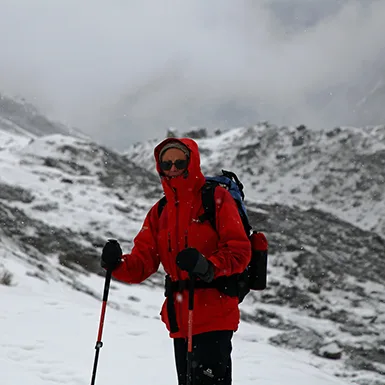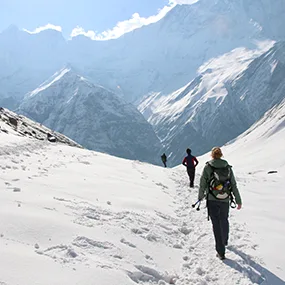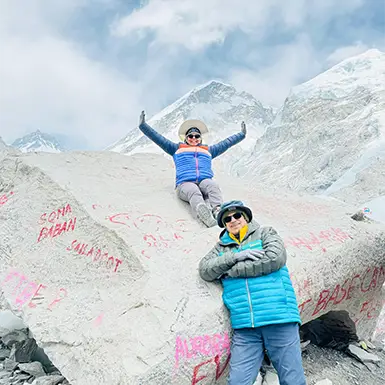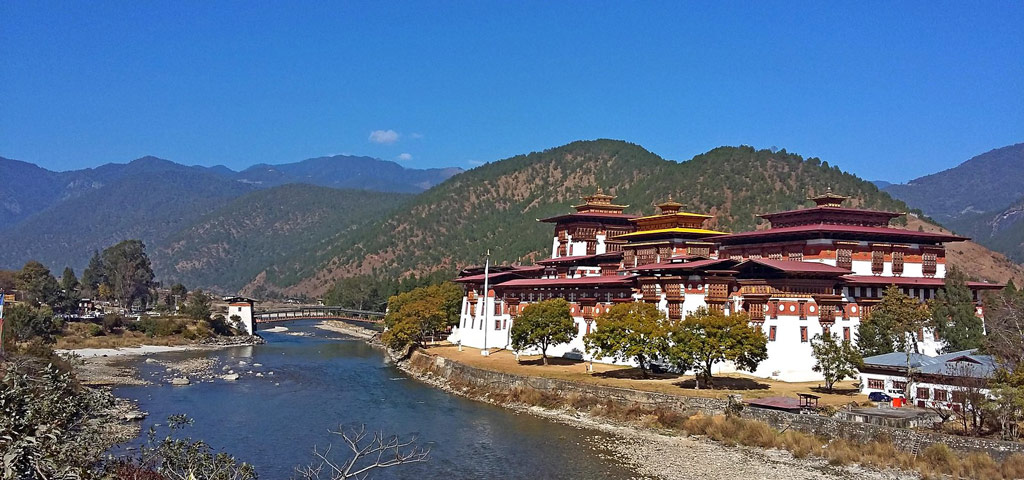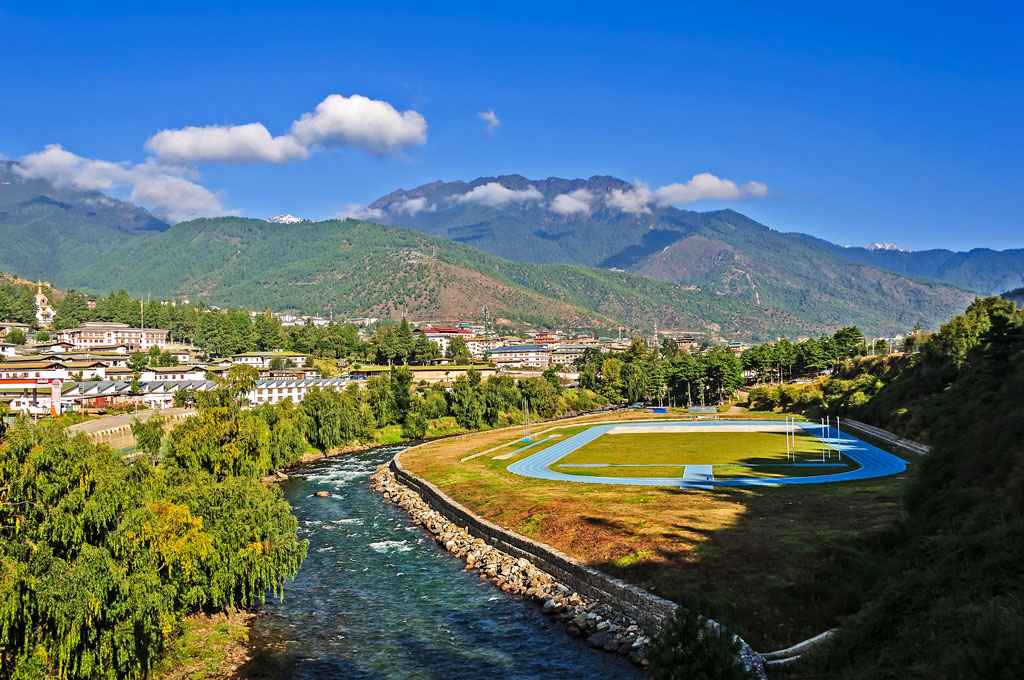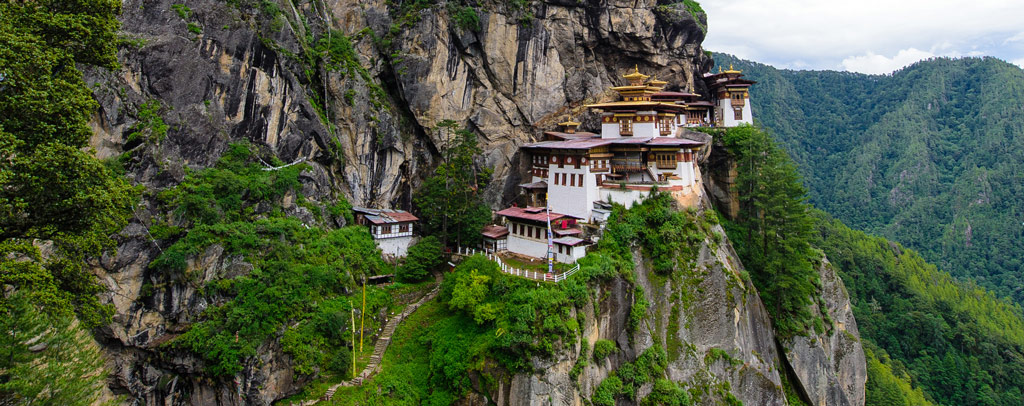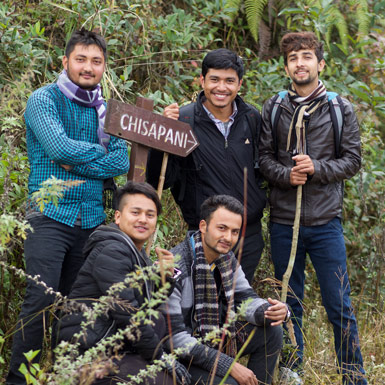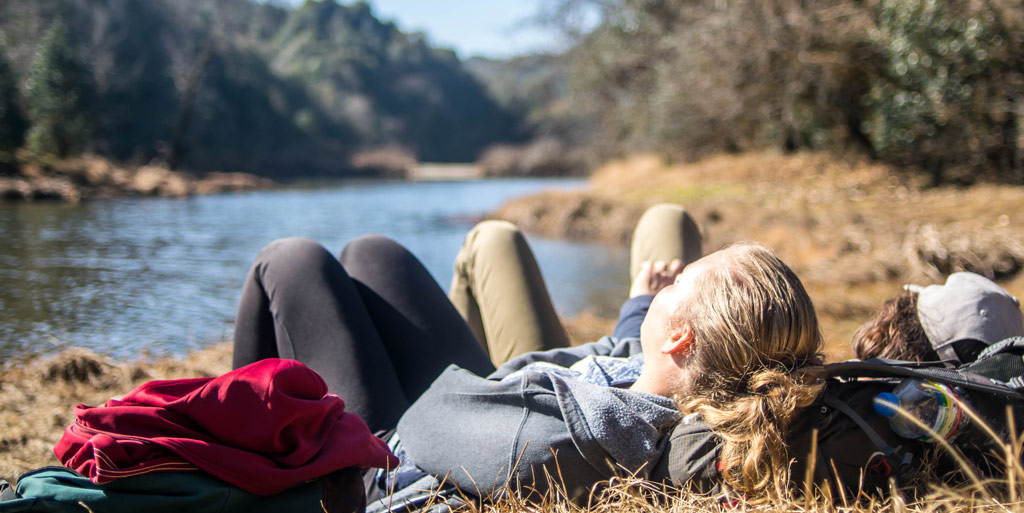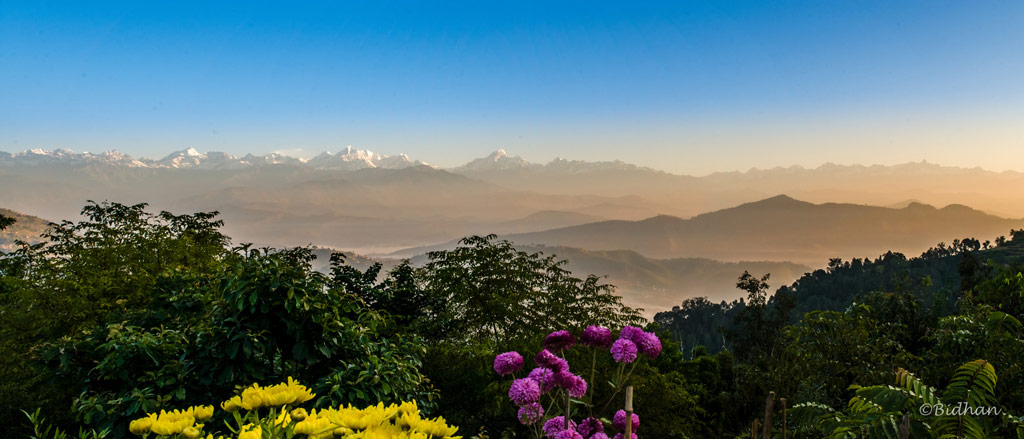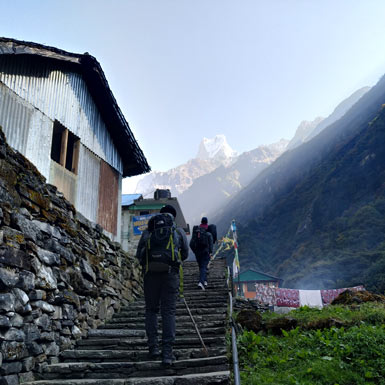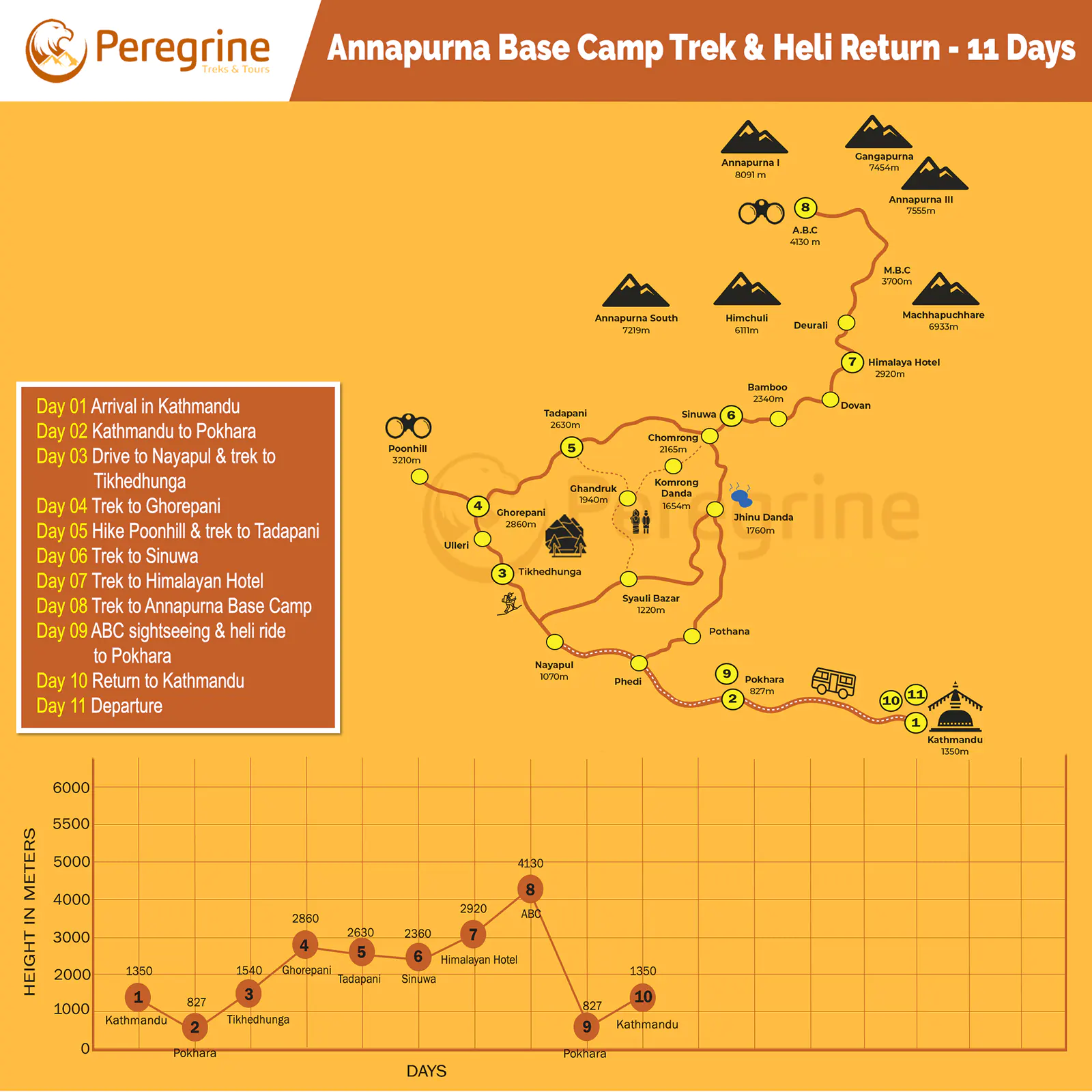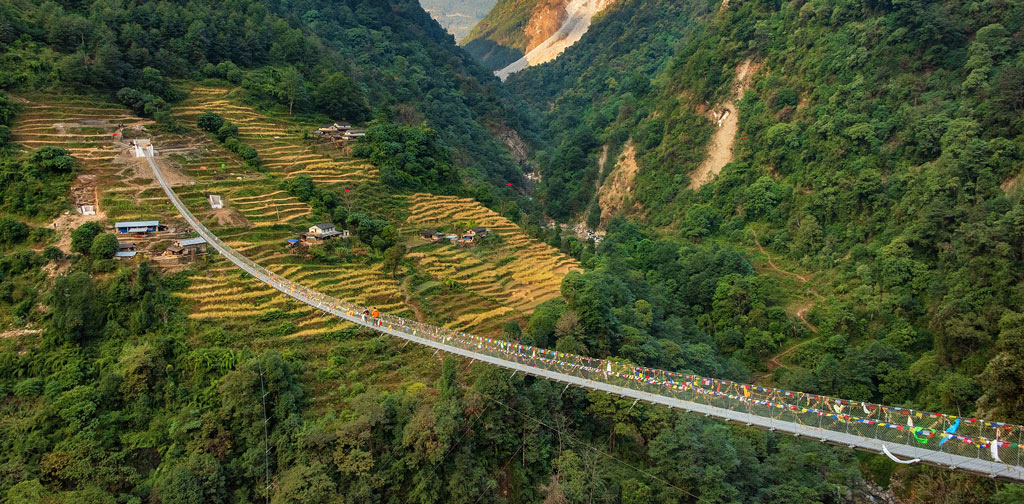Day 5 of the Tsum Valley Trek Diary
Friday, April 30th
In my Tsum Valley Trek Diary, today starts with Pheri leaving early for Kathmandu. The rain had slowed down, but it rained all night, which is typical for this area near Tsum Valley (though we weren’t officially in Tsum Valley yet). It’s easier for Ram and me to trek as two people instead of three. This smaller group will make things faster in the coming days.
Pheri’s leaving also meant Ram and I could connect better. Before, Ram was lower in status as a porter. Now, it was just the two of us. We finally had time to talk. I found Ram to be a great guide. He was very patient with my slow walking speed. Arthritis makes walking painful and slow for me.
Then, we realized a problem. Pheri had left with all the trip money! I only had about 7000 Rupees with me. This was not enough money to finish the Tsum Valley Trek. However, we didn’t want to turn back. We decided to walk to Philim. Philim is the next village where we could find a phone and call Pradip for help.
There are no banks in this area. The last place to send money was Machha Khola Gaon, but we didn’t know how they could give us the money even there. Here, people mostly use cash to trade goods. There are a few other options for money.
The rain became a light mist when we left Salleri. We continued north on the trail. We passed Paimo, a ghost town. No one lives there anymore. A big rockslide destroyed the city.
Rockslides are common in the monsoon season. The ground gets very wet, and rocks become loose. When rocks start to fall, they destroy everything in their path. Whole villages can be wiped out quickly. Many people and animals can die. It makes you realize how fragile life is in the Himalayas. People who live here are strong survivors. They live despite facing many dangers.
The trail started to climb steeply. We passed Mani’s walls. These walls have Buddhist prayers carved on them. We walked downhill and around Sirdibas village. There are small streams in Sirdibas. Local grain mills use these streams for power.
Just past Sirdibas, we crossed a long suspension bridge. This was our last time crossing the Budhi Gandaki River. If we kept going north, we would reach Mount Manaslu. But we are doing the Tsum Valley Trek. So, we crossed to the east side of the river and walked uphill to Philim village.
Philim is the last big village we will see for a while. It has a school, three hotels, some shops, a phone, and good food. We called Pradip from Philim. We told him about our money problem. He said if we could reach Lamagaon, we could ask his friend at the hotel there for a loan. If we are careful with our money, we have enough to get to Lamagaon.
We sat down and had lunch. We ate vegetable momos with yak cheese and ketchup. I have started to like ketchup a lot here. Maybe it’s the potassium, but I want to eat it. Sadly, this might be one of the last places to find ketchup.
We went through the checkpoint and registered our permits. Then, we walked north again. The trail followed the mountainside. It went up and down. Small rivers made beautiful waterfalls as they fell down the mountains. The waterfalls flowed into the Budhi Gandaki River far below. Eagles flew high above us, circling in the warm air. They looked for food in the valley. The clouds disappeared. The sky became sunny and blue.
We passed two small villages on the east side of the river. The first was Eklebote. It has a great view of the river. The second was Chisapani. Cold water flows from taps in Chisapani for people to use. Neither village is enormous. Both are starting to build guest houses.
After Eklebote, there were no more villages. Civilization ended. We walked further north. Houses disappeared. We saw colorful butterflies flying around. But we were mostly alone, without seeing other people.
We reached where the Chhilung Khola River flows into the Budhi Gandaki River. The Budhi Gandaki River is much smaller here. It rushes over rocks. Here, we saw a sign welcoming us to the Tsum Valley Trek! We had reached the entrance.
We were not yet in Tsum Valley itself. We still needed to walk through a narrow gorge to enter the lower valley. This place is likely the edge of the Village Development Committee area. Here, the trail split. If you go left, you reach the Manaslu Trail. You cross the Budhi Gandaki River on a small steel bridge to go to Manaslu. If you stay right, you are on the only path to the Tsum Valley Trek.
The trek to Tsum Valley climbed higher. We could look down at the Manaslu trail as we climbed. Our goal was Lokpa village. Lokpa is 805 meters higher than Sirdibas.
The climb was steep. Sometimes, there were steps. Other times, we walked on loose rocks. It was late afternoon. The weather started to get worse. It began to rain. It rained hard on Lokpa.
Because of the trees and rain, we could not see that we were leaving the Budhi Gandaki River. The Budhi Gandaki River gets its water from the melting glaciers of Manaslu Mountain. The first big river that flows into it is the Syar Khola. Syar Khola is the main river of Tsum Valley. Syar Khola River made a narrow gorge. We must walk through this gorge to reach the lower Tsum Valley.
Lokpa village is just past where the rivers meet before the gorge. It has only one guest house, a small shop, and a few houses around it. Lokpa is not much of a village, but we were happy to be there. We were tired, cold, and hungry.
We got to Lokpa as it got dark. I went to the kitchen to warm up by the fire. The temperature had dropped to about 12°C. We were now at 2240 meters high. We could feel the cold. I put the bottom parts back on my zip-off pants to get warmer. I drank hot tea by the fire.
Lobsang Furgang runs the New Tsum Hotel. He is a widower with seven children. He built the guest house. It has small rooms upstairs for sleeping. Most rooms sleep two people. There is just enough space between the beds to walk. Two rooms are “single” rooms. These rooms are tiny, like closets. They are just big enough to lie down in. You have to crawl into these rooms to sleep.
We are the only guests tonight. I ordered macaroni with yak cheese and lots of ketchup. I looked around the shop. It has many things from China. People here get supplies mainly from Tibet. They can cross the border with yaks easily.
The first thing I saw was Lhasa Beer in cans. It was cheaper than beer back near Arughat Bazar. They also had a barley wine in a can from China. It tasted different, but it was perfect. The shop also sold many cheap sneakers in one color from China. They cost 860 Rupees. I got under the thick blanket in my room upstairs. Soon, I fell asleep.
Day 6 of the Tsum Valley Trek Diary
Saturday, May 1st
In my Tsum Valley Trek Diary, today begins with the sun shining early. A rooster crowed loudly. He knew we could not eat him. People in this Buddhist area do not eat meat. They do not kill any living thing. This rooster was bright. He knew he was safe from becoming our dinner.
I went downstairs for breakfast in the dining room. Today will be a long day. We will hike through a canyon to reach the lower Tsum Valley. It was cold. But the rising sun promised a warm day.
I looked around Lokpa village. There was not much to see. However, Mount Manaslu looked terrific to the west. It was bright white against the blue sky. It was a beautiful view from our higher elevation. Ram and I got our things ready. Then, we started our walk into the restricted Tsum Valley.
Tsum Valley was closed to outsiders until recently. But the people here have prepared well for tourists. Guest houses and homestays are in almost every village now. Even two Buddhist monasteries that once opposed tourists now rent rooms.
Tsum Valley is a Tibetan Buddhist land. Almost every village has a Lama and a Gumba (monastery). Most Gumbas do not have monks living there all the time. Only during festivals do monks come. Usually, a village Lama takes care of the Gumba and meditates there.
We reached the highest point of the trail at Lokpa. Now, the trail started to go downhill. We saw workers building a new suspension bridge at the first river. It will replace an old, shaky wooden bridge that is further down.
Building suspension bridges in the Himalayas is hard work. These bridges are only for walkers and donkeys. But everything that makes people must be carried in them. The cable, metal parts, and concrete were all carried by donkeys or people.
Nepali people are strong carriers. They use a strap around their forehead to carry heavy loads. They can hold 100 kilos this way, walking up and down mountains.
At the bridge construction site, families lived in plastic tents. They will stay there until the bridge is finished. Then, they will take down their tents. Some families will return to their farms. Others will go to the next bridge-building job.
They use no power tools here. Everything is done by hand. It is slow work. But there is no other way here.
Another suspension bridge was further down the trail. But we went to the old wooden bridge. Near the old bridge, the Lungwa Khola River has pretty waterfalls. I stopped to take pictures. We could hear the Syar Khola River rushing behind us.
The trail down was steep and sometimes rugged. Our goal was Sardi Gorge. The Syar River flows through a narrow channel in this gorge. This gorge is the actual entrance to the Tsum Valley Trek.
The land before the gorge was green and lush. There were many plants and water. This green land attracted Tibetan Buddhists over 1000 years ago. They settled here. It was also a safe place to hide from enemies. Tsum Valley was rugged to enter. This isolation helped them keep their way of life unchanged by the outside world.
The trail was on the south side of the Syar River. It was just a few feet above the river on steep slopes. The trail was narrow as it went down. This gorge was the narrowest and lowest point of the Tsum Valley Trek. After we passed through the gorge with its high rock walls, we would start climbing again.
We did not meet any other foreigners on the trail. But we met people from Tsum Valley. They greeted us warmly with “Namaste!”. In other parts of Nepal, foreigners are familiar. But here, people are still surprised to see us. More tourists are visiting the Tsum Valley Trek, but numbers are still low.
People in Tsum Valley are peaceful. They are very welcoming. They treat every stranger like family. People offered us eggs, local alcohol called Roxy, and other gifts just to be kind.
We quickly noticed there were no houses along this part of the trail. People do not live here in the gorge. This trail is to get through the gorge and into Tsum Valley. Sadly, after the gorge, we saw little water for the rest of the day. My water bottle was getting empty. The air was dry, and I needed to drink.
There was only one “village” marked on the map. It was called Gumkhola. Gum Khola River falls down the mountain into Syar Khola at Gum Khola. The village was just one house. It was a tea house run by a man and his young nephew, who was about four years old. The nephew was adorable. He greeted everyone with “Namaste” and took money for purchases. We arrived in the afternoon. I ordered tea first. Then, I realized it was also a shop and a food place. So, I ordered a cold Coca-Cola. They kept it cold in the Gum Khola River water.
The man and his nephew were friendly. Ram talked with them while I looked at a newborn calf in a shed nearby.
Just past Gumkhola, the trail split. If you go right, you reach Ripche village. If you go left, you reach Chumling. Chumling is the main village of this area and our goal for today.
Our trail went across a suspension bridge over the Syar Khola. Then, we climbed up the north side of the valley. The trail became switchbacks. Gumkhola village looked smaller and smaller below us.
Finally, the trail leveled out. We walked under a Kani. A Kani marks the entrance to villages in Tsum Valley. A Kani is a typical Tibetan gate. It shows the division between the town and the wild area outside.
Kanis are usually made of stone. They often have colorful paintings of Buddhist gods and village protectors. Kanis can also give shelter from rain. Luckily, we did not need shelter when we reached Chumling. The skies were sunny.
Chumling is the main village of the Chumling area. It has two guest houses. It also has a very old Gumba. They are rebuilding the Gumba because the weather has damaged it over centuries.
We stayed at the Tsum Valley Himal Hotel. It had one big, clean room with thick blankets and many beds. It also had free filtered water. The restaurant was open on one side. We ordered dinner there. The food menu was tiny. But it was a nice place to stay.
The Donkey Men
Several men with donkey trains stayed at the hotel, too. Most were young and looking for adventure. Working with donkey trains is a good way to earn money in the mountains.
The work is hard. They walk with the donkeys and keep them moving. They work all year. They earn about 18,000 Rupees or more each month. This is good money in the mountains. But the work is dangerous. Each donkey carries about 60-65 kilos of goods. Goods include oil, cigarettes, whiskey, and soda.
Sometimes, donkeys carry propane tanks. Donkeys are the only way to get gas tanks into the mountains. Some of these men travel from the Tibetan border to Chhoking on the Manaslu trek. They walk in snow, rain, and all kinds of weather to keep the donkeys moving. Donkeys can be stubborn. The men wake up at 3 AM every day. They load the goods on the donkeys and start walking.
The donkey owner was Puina Bahadur Gurung, 30 years old. He started as a donkey trainer at 17. He saved money to buy his donkeys.
Donkeys are expensive. They cost about 70,000 to 90,000 Rupees each. Purina said one donkey could work for about 16 years or longer if well cared for. He is married and lives in Soti Khola. He makes four trips a month from the Tibetan border to Soti Khola. He owns eight donkeys.
Usually, donkey owners travel in groups. It is safer that way. These men also carry money from the mountains to the markets. They buy goods and bring back cash from sales. They are not just transport. They are also like mountain bankers.
One danger is donkeys falling off mountain trails. Donkeys are good on their feet. But it is dangerous when donkeys meet on narrow trails. Sometimes, a donkey falls off the mountain. This is a loss for everyone. If a donkey falls, it usually cannot be saved. The monsoon season has its dangers. Rockslides can destroy a whole donkey train in minutes.
Despite the dangers, these men are friends. They seem to enjoy working on the trails. It is also a good way to earn money in the mountains where few jobs exist.
Day 7 of Tsum Valley Trek Diary
Sunday, May 2nd
In my Tsum Valley Trek Diary, Sunday began with a loud rooster. The rooster crowed early. He knew we could not eat him. As Buddhists, people here do not eat meat. They do not harm any living creature. This rooster was safe from becoming breakfast.
I went to the dining room for breakfast. Today, our Tsum Valley Trek Diary entry will describe a long day. We will walk uphill 800 meters on a steep, narrow trail. We are going from Chumling to Chumchet.
Chumling and Chumchet are close on the map. But for me, it felt like a full day’s trek. Chumling is in the valley. Chumchet is higher up on a ridge. Chumling feels a bit more modern. Chumchet is more traditional than the Tsum Valley.
Saying Chumling is “urban” is funny, though. It is just a few houses, two guest houses, and an old Gomba. However, Chumling is on the main trail to the upper valley. Chumchet gets fewer visitors. People in Chumchet are very traditional. They rarely wash. Their faces are often dirty with soot. Their clothes are often unwashed. This is common in Chumchet. Also, many here speak only a local Tibetan dialect, not Nepali. Many have little education. School is far away, and teachers may not always be there.
Chumling has more flat land for farming—Chumchet farms on terraces on steep mountainsides. Terraces in Chumchet are very narrow. They are just wide enough for two rows of corn.
Churches also have little water. Chumling has many springs for water. So, Chumling and Chumchet are pretty different.
There are reasons why people in Tsum Valley do not bathe often. Water is scarce, especially water that is not freezing glacier water. Washing in glacier water is extremely cold. The cold water can shock your body. It is hard to get used to.
Hot showers do not exist here. People bathe in public areas. No one wants to undress in the cold wind with freezing water.
Houses are not heated. Except for a Chinese iron stove in the kitchen, houses are cold. People gather in the kitchen for warmth. Initially, they used open wood fires. Now, Chinese metal stoves are ordinary. They come from Tibet. Often, these stoves have no chimney. The heat stays in the room. But so does the smoke and soot. People get used to the smoke and soot. Soot covers everything in black.
Tibetan people are very tough in the cold. They can walk barefoot in the snow. They do not get frostbite quickly. Mothers put yak butter on babies. They believe it protects from evil spirits and cold. Their skin becomes tough like leather, especially their feet. They can walk barefoot on sharp rocks and climb mountains easily.
People in Chumling seemed cleaner. They were more like people in other parts of the world regarding hygiene. Chumchet was different. It was worth seeing to understand the traditional Tsum Valley Trek.
We started walking to Chumchet that morning. Our first stop was Chumling Paykup Gompa monastery. It is over 600 years old. It is one of the oldest monasteries in Tsum Valley. Today, the building is in bad condition. But we heard they would start building a new one tomorrow. Years of harsh Himalayan weather have damaged the old building.
Inside, there were statues of Buddha and local gods. There was a large prayer wheel as tall as the room. The building had no heat. Lamas and worshippers come here to pray and meditate, even in the cold.
The valuable things in these Gombas are the scrolls, not just statues. They have Tibetan sacred writings. Many scrolls teach about Buddha’s words. Lamas study and meditate on these scrolls. Gompa is an essential place for holy texts.
Different types of Tibetan Buddhism are practiced in Tsum Valley. They are similar but have some differences. At Chumling Paykup Gomba, the Lama does not marry. However, in Chumchet, the Lama is married and has children. There are five main types of Tibetan Buddhism in northern Nepal: Nyingmapa, Kagyupa, Sakyapa, Gelugpa, and Bön. I did not learn their differences on this Tsum Valley Trek, except that Nyingmapa Lamas do not marry. This Gomba might be Nyingmapa.
This Gomba is on a small hill. It looks over the farms around it. The day was sunny. The mountains were beautiful, with snow-covered peaks shining in the sun.
After the Gomba, we walked through farms. The trail was flat and narrow. Stone walls marked farm borders. The flat trail soon ended. We started climbing the mountain.
We met local people. They smiled with bright white teeth against their sooty faces. They offered us eggs from their pockets. At another place, they drank Roxy, a local alcohol. They provided us with sips from their used soda bottles. We said no to the drinks but enjoyed talking with them.
The trail became steep. We walked into a pine forest. The forest slowly thinned out. Trees became fewer. Then, the trees disappeared utterly. Suddenly, we smelled cedar trees. Water flows here for part of the year. Monsoon rains and heavy rains make temporary rivers. This makes the land moist. There are also many small caves in the rocks. Many Buddhist Chortens are on high points along the trail.
Buddhists build Chortens to honor the dead. They believe it brings good luck in their next life. Chortens are made of stone. They have stones with the Tibetan chant “Om mani padme hum” written on them. Chortens are also good rest stops for travelers. Ram found a grassy spot. He lay down for a nap. I joined him. We napped in the sunny afternoon.
There are no houses or shops on the way to the Church. The land is too steep to farm in most places. It is primarily wild nature. We had no lunch. We were hungry until we reached Chumchet.
We finally arrived in Lower Chumchet in the late afternoon. Lower Chumchet is just a few houses. People greeted us with smiles. They were shy at first when I took photos. But when they saw their pictures, they changed. They started posing. They grabbed things to pose with.
Maybe this was their first time seeing a digital camera. Maybe. This place does not see many outsiders. Outsiders were mainly kept away until 2008.
We finished taking photos. Then, we went to the upper village. We looked for the Lama to ask about staying there. Upper Church was not as friendly. People did not even open their doors when we knocked. It was very different from the lower village.
But we found the Lama’s house. Lama Buchimallama has been the village Lama for 10 years. His Gomba is 15 minutes to one hour above the town. It was getting dark. Sadly, we had to say no to visiting his Gomba then. He and his family run a homestay. They welcomed us into their home. They sat us on the floor in a small room. This room was also their home chapel. We would sleep here for the night.
They brought blankets and mats. They put mats on the cold floor for us. There were no chairs. Outside, it was already 10°C by 5 PM. It would get colder as the sun set. There was no heater in the room. I wrapped a blanket around myself. I was glad I had brought long underwear. I would put it on later.
Children stayed away at first. They peeked into the room windows to look at us. We were like animals in a zoo to them. Then, the Lama came from the kitchen. He brought steaming butter tea.
Butter tea is a Tibetan drink. It is tea with yak butter in it. It tasted good. But it has a strange aftertaste. It takes time to get used to.
Butter in tea seems like a lot of fat. But in their diet, they need fat to stay warm. They eat corn, wheat, barley, rice, and potatoes. They do not eat meat here. Butter tea gives them much-needed fat.
Ram made bread for dinner. They kept bringing butter tea. Later, the Lama switched to Roxy. Roxy is a local alcohol made from barley. People drink it all day: breakfast, lunch, and dinner. Roxy is clear. Some Roxy is strong. Some are weak, like water. I drank Roxy with our host. It made me feel warm. It did not have the aftertaste of butter tea.
The sunset. The only light in the room was from butter lamps on the altar and one solar-powered light bulb. Children slept on the porch outside. The windows had no glass, just cold mountain air coming into the house. I got into my sleeping bag and put a blanket over me. I fell asleep quickly.
Day 8 of the Tsum Valley Trek Diary
Monday, May 3rd
In my Tsum Valley Trek Diary, Ram and I woke up with the first sunlight. The sun came into the house early. It was going to be a nice day. Sadly, it would rain by afternoon.
Children were already awake, looking at us. The Lama came with hot butter tea. I drank the warm tea. Ram went to the kitchen to make bread for breakfast.
The children became a little braver. But they still stayed back. They barely came into the room. Finally, the cat came over. It sat on my lap. The children decided I was okay – I did not eat the cat! They were still careful. But they moved a little closer.
Chumchet is at 3200 meters high. We would walk downhill to Tumje. Tumje is at 2440 meters. We would go down 760 meters today.
Yesterday, we saw tiny blue, yellow, and white flowers on the trail. Today would be different. We would see little green on this mountain trail except for a few small rivers.
The mountain is dry. The closer we walked to Tumje, the drier it looked. Finding water to refill my bottle would be hard for much of the day. The trail looked empty. We saw very few people. However, we did see a jackal above us.
According to the Lama, Chumchet has about 40 people. There are about 70 houses, no guest houses, a Gomba, and a primary school. The school is usually closed, he said. His home seemed to be the only place for visitors to stay. It was nice, and he and his wife were very welcoming.
The downhill walk started almost right away. We passed only one village on the way down. Its name was Khar. It was just a few houses. The men were out working. We saw a few women working. I hoped to find a small shop with Coca-Cola. No luck. Khar village had no shops at all.
Ram usually walked ahead of me. He walks faster. I liked this. It gave me time to enjoy the views without feeling rushed. I know I am slow. I know it is hard for guides and porters who are used to walking fast on these rocks.
We kept going downhill. Clouds hid the mountains. I heard thunder getting louder. The temperature dropped. The wind picked up. Then, it started to rain steadily.
I wish I had brought light gloves. I use two walking sticks. My hands were freezing. I had an extra-large handkerchief. I wrapped one hand in it to keep it warm. The other hand was icy and hurt.
Down… down… down the mountain, I went. I slipped on rocks as I walked through switchbacks. I could not see Ram. Finally, I saw him. He was taking shelter from the rain in a small cave.
I stood outside in my yellow raincoat. The other day, I thought it was too warm. Today, it was perfect against the cold Himalayan wind and rain.
Domje village is the entrance to the upper Tsum Valley. It is where three rivers meet. Two rivers flow into the Syar Khola here. This area is farmland. But Domje village did not look wealthy.
We stayed at the only guest house in Domje. It was run down. We had to climb a shaky ladder to the sleeping area. The door closed, but it did not matter. A big window, about 5×5 feet, was always open. The other side had a smaller window with no cover. The beds were just wooden boards. I put out my sleeping bag and used a blanket on top. It was late afternoon. The temperature was already 8°C. The wind blew through the room.
They did not have much food. But Ram found some boiled potatoes. We warmed them up. Luckily, they had Coca-Cola. It was good and cold. Who needs a refrigerator when you have ice-cold mountain streams nearby?
Day 9 of the Tsum Valley Trek Diary
Tuesday, May 4th
In my Tsum Valley Trek Diary, today’s goal was Lamagaon. Lamagaon felt like a faraway, legendary place to us. Reaching Lamagaon was our main aim. We hoped to borrow enough money there to finish our Tsum Valley Trek. Today, we plan to climb to the upper valley. We would finally reach our essential stop.
At 6 AM, it was 7°C. I did not want to get out of my sleeping bag. The sun looked pretty, but the room was cold. The wind blew through the room. At least my sleeping spot was dry. I was not sure about other places in the room.
Ram made flatbread for breakfast. We ate quickly and left. We walked through fields. Then, we joined the trail. The trail led to a suspension bridge over a river. Early on the trail, I got diarrhea again. I do not know why it happened then. Luckily, it only happened twice today. It was not a big problem.
Soon, we reached a beautiful village called Gho. Gho is built on a mountainside. It looks over Domje. Gho has colorful houses and a pagoda-shaped Gompa. Gho had one tiny store. It was built into the hillside. A woman cooked inside. Her young son peeked at us from the doorway. They had ice-cold Coca-Cola. We enjoyed drinking it.
Domje is at 2440 meters high. Lamagaon is at 3305 meters. We had a lot more climbing to do. We were now back on the main trail. We climbed up stone steps.
Today, we met some other foreigners on the trail for the first time on our Tsum Valley Trek. One was a woman from Austria. We met her again later. She wanted to trek to Manaslu. But snow closed that trail. So, she decided to visit Tsum Valley while waiting for Manaslu to open. We also met a man from Mexico and his travel partner, a woman from Russia.
Meeting people is a fun part of trekking. Nepal attracts people from all over the world. You meet people from many countries on these trails. We also met people from Canada, Switzerland, and Germany on our Tsum Valley Trek.
We also met students from Tribhuvan University in Kathmandu. They were doing fieldwork in Tsum Valley. Sometimes, the trail was only rocks. Other times, colorful flowers grew beside the trail. Butterflies flew around us. Hawks and eagles soared above.
Ram worried about money. He wondered if Pradip’s friend would be at the guest house. What would we do if we could not borrow money? I told him, “God will provide.” He looked at me strangely. He asked, “God will provide?” I said, “Don’t worry. It will be okay. Have faith.” He just shook his head. He was not sure about what I meant.
Finally, around noon, we reached the top of this mountain trail. We were hungry. The next village was Chhokung, Paro. It is the main village of the upper Tsum Valley area. We walked through a forest. Then, we reached a Kani gate. The Kani gate marked the start of the village. We were happy to reach Chhokung, Paro. We hoped to find food after our night in basic Domje.
The upper valley is relatively flat. It is between two mountain ranges that surround Tsum Valley. The flat area is not very wide, maybe just over a kilometer. But it is flat for Nepal! It has good water. It is a good place to farm. These flat fields drew the first Tibetan people here over a thousand years ago. We walked by stone walls. The walls separated farms. Then, we walked under another Kani gate as we entered the village.
ChhokungParo looks very Tibetan. Houses have walls around them. The walls enclose a barnyard. Only a wooden door opens to the street. Inside the walls, houses are usually two stories. People live upstairs. Animals and food storage are downstairs.
The walls give the village a feeling of old times. The town was quiet. Only one woman drew water from the well. Most people were out working in the mountains. They were farming, caring for animals, or collecting herbs for medicine.
All three guest houses were closed. They had no guests right now. The Mexican man and his Russian girlfriend were also there and hungry. But there was no food anywhere open.
Ram convinced a teacher in the village to have his wife cook for us. They welcomed us in. She cooked us a fantastic noodle soup. It was one of the best soups I have ever eaten. I do not know what vegetables she used. But it tasted wonderful. They also had Chinese sodas. We drank some sodas, too.
We talked to the teacher. He told us about the valley’s history as we ate soup. ChhokungParo was disappointed because everything was closed. But it was a pretty village. It has its own Gomba. Another big Gomba is just north of the town.
North of the village, a school was being built. Local people donate at least 20% of the school’s cost, often with their work. The schools are built of heavy stones from the area. Women and donkeys carry the heavy stones to the building site. Stone workers shape the stones to fit together. A skilled worker can shape a stone in about 10 minutes.
Schools are a problem in Tsum Valley. The population is small. Families with money send their children to Kathmandu or Pokhara for good schools. Children as young as five walk for days to Soti Khola. Then, they travel to Kathmandu or Pokhara and live there. They only see their parents on holidays.
Local government schools are not seen as good. This might be true or not. We met some good teachers. It is hard for Tsum Valley to find teachers. It is isolated. Also, most teachers from Kathmandu do not speak the local Tibetan language. Teachers quickly find a language problem with students and parents.
Most women here do not speak Nepali. They often cannot read or write. They only speak their local Tibetan language. This creates many problems. Children first learn their Tibetan dialect. Most children get little education unless they leave the valley for Kathmandu.
Tsum Valley needs educated people to come back and teach. They would know the local language. They would also know Nepali and English from their education.
The trail kept going uphill. But it was a gentler slope in the upper valley. The upper valley is “Nepali level.” This means it has hills, but it is pretty level for Nepal. Level ground is rare here. Something called the level in Nepal can still be a bit slanted. Even a 15° slope is considered flat in a land of steep mountains.
The next village was Ngaku. Ngaku was like a smaller ChhokungParo. It had no guest house but a homestay. Walls along the paths made long shadows in the afternoon sun. Everything was mainly closed, just like ChhokungParo. One young boy followed us. Ram found a woman to ask for information. Ngaku village had a Gomba but no Lama. Instead, a nun lived there.
Our next village was Lamagaon. We reached Lamagaon as it got dark. The only guest house was just past the village. We aimed to stay there and meet Pradip’s friend, Norgay Lama. He could help us with money.
We arrived. Norgay’s wife, Dawa, welcomed us. Staying there was good. Sadly, Norgay had left for Kathmandu that morning. We had passed him on the trail without knowing. The phone was not working. Pradip could not reach him.
Ram panicked. “What do we do?” he asked. I told him again, “God will provide.” That was our only choice, besides eating lizards, which is not done here. Lizards are not so bad if you have barbeque sauce. And ketchup can make anything taste better.
Day 10 of the Tsum Valley Trek Diary
Wednesday, May 5th
In my Tsum Valley Trek Diary, we went to bed early last night. We slept in the only room for guests. It was also their home altar room. The window had no glass. The cold night air blew into the room. There were no beds, just blankets on the floor. We put our sleeping bags on the blankets. I got an extra blanket to put over my sleeping bag. It would get down to 4°C. I wanted to be as warm as possible.
We sat with the family and ate the mashed potatoes that Ram cooked. We drank butter tea. Here, the butter tea was not as bitter as in Chumchet.
A Tibetan house usually has one main room upstairs. You enter through a side room for storage. When your eyes adjust to the dim light (no windows), you find the doorway to the main room.
Two walls in the main room are for kitchen items. Copper bowls and jars are neatly arranged on shelves. Large copper pots hold water. There is no running water. Women must go to a well, carry water back, and bring it into the house. Houses now have Chinese cast iron stoves. But they do not give much heat to the whole house. I sat near the stove and still felt cold. But these people live with this cold all year. They are used to it.
There is a bed couch by the only window in the room. The window has plastic over parts of it. But the wind still blew through. The window frames are beautifully carved with tiny squares that would be perfect for glass, but glass was not there.
I wrapped a thick blanket around myself as we ate dinner. Then, I went to our room to sleep. Our room was also a temple. It had a picture of the Dalai Lama and a picture of the local Lama from Rachen Gompa. Rachen Gomba’s Lama is very respected in Tsum Valley. He is not as famous as the Dalai Lama, but he is critical here. We will meet him later today.
Dawa, Norgay’s wife, took care of us. She did not know her age. But she knew she had been married for over 20 years. They have four children. All the children were away at school in Kathmandu or Pokhara.
Dawa had traveled outside Tsum Valley. She had been to Kathmandu and India. In India, she met the Dalai Lama.
Her work is cooking, farming, and making rough blankets. Blankets like these are standard in their homes. She also runs the guest house. She likes meeting travelers who stay there.
She had a helper, a young relative named Dolpa. Dolpa is about 11 years old. She does not go to school. She cannot read or write. She is very hardworking. When not cooking or cleaning, she spins wool on a distaff. She has a bright smile and is happy.
Across the Syar River was Rachen Gomba, one of the biggest Gompa in Tsum Valley. Rachen Gomba is home to Lama Dukpa Rimpoché. He is in charge of four monasteries. Two are in Tsum Valley: Rachen Gomba and Mu Gomba. Two others are in Kathmandu. We would visit him today. We crossed the Syar River on a suspension bridge. Then, we hiked to the monastery. The weather was cold. The sky looked cloudy. I wish I had brought my raincoat for this day trip.
The monastery covered a large area. They were building a new Gomba and rooms for 113 monks and nuns. We met Swiss trekkers there. They had arrived before us. They were camping. Their porters were cooking spaghetti. It looked good. I have eaten noodle soup and Tibetan bread for most of this Tsum Valley Trek. Having a porter who was like an Italian chef was a nice treat for them. I hinted that I was hungry. But they only gave us cups of hot tea. Well, at least the tea was hot on this cold, windy day.
A nun told us the Lama was eating lunch. We could not bother him then. We waited outside until it started to rain. Then, we went into part of the old Gomba.
The only heat in that room came from butter lamps. The new energy-saving light bulb gave no heat. The window in the room had no glass. A cold wind blew in.
Finally, we met the Lama. He was about 66 years old. He had some health problems, including hearing loss. He greeted us warmly. He invited us to sit on a mat on the floor. He sat cross-legged on a low couch.
The Lama was impressive. He had studied Buddhist scriptures since he was 7 years old. His group promises to be celibate when they become Lamas after graduation. Their studies take about 20 years. After that, they keep studying the sacred scrolls.
Because of his age and health, he now only teaches the Lamas-in-training. He has six teachers helping him. These teachers teach others who are learning. The new Gomba will be much bigger and grander than the old one. It will also have glass windows.
We took a photo of the Lama. We thanked him for his time. I could see he was tired. I did not want to stay too long. I asked him about tourism in Tsum Valley. He said only time would tell the impact. Rachen Gomba does not have guest rooms. But Mu Gomba does. Mu Gomba is one of two monasteries in Tsum Valley that offer lodging for tourists.
The rain became heavier. I tried to go into the Lama’s kitchen to get warm. Ram stopped me. He said I could not go in there. Only nuns are allowed in the Lama’s private kitchen. It was like trying to enter the Pope’s kitchen! I was still shivering. We went back to the room with the prayer wheel. But it was not warmer there. Finally, Ram suggested running to the big kitchen across the area.
We ran as fast as we could in the cold, heavy rain. It was a prominent place. It took a while to reach the kitchen. We got to the kitchen and sat by the fire.
No one stopped us. They even offered us butter tea. Anything hot was welcome. I was sipping tea when a nun shouted, “It’s snowing outside!”
And it was true! Big, fat, white snowflakes mixed with the cold rain. It was May, and it was snowing!
The kitchen was busy with young monks and nuns. They acted more like teenagers than holy people. But that is normal for teenagers. The girls were working. The boys were joking around. The girls started making chapatti bread. I hinted again that I was hungry. It was now 2:30 PM. We had not eaten since breakfast. We got more tea. But the chapatti was for the monks, not for us.
We sat for over an hour. Then, we decided to go back to the guest house. It was Ram’s idea. I was thinking of finding an empty room at the monastery and sleeping there for the night! With 113 rooms, there should be a free room somewhere. I had not worn my long underwear. I did not have a warm jacket. I only had a sweatshirt, which was not warm enough in this rain and snow. I had left my raincoat at the guest house since it looked sunny that morning.
The snow and rain slowed down a little. We made a run for it. A dog came out and barked at us. Many Buddhist monasteries seem to have a mean dog that dislikes visitors. This dog was chained up, luckily. It was big and scary. It looked like it wanted to eat me, even though meat is not allowed here for Buddhists.
We left the Gomba and ran down the hill. We crossed the dry river bed. Then, we climbed up to the bridge over the Syar Khola. We walked much faster this time. We wanted to get out of the bad weather.
We got back to the guest house. We learned that “God had indeed provided,” as I said to Ram earlier. Norgay had returned to Lamagaon!
Day 11 of the Tsum Valley Trek Diary
Thursday, May 6th
In my Tsum Valley Trek Diary, I wrote yesterday about worrying about money. But, as I told Ram, God would provide. And God works in surprising ways.
Norgay was going to Kathmandu. He reached Lokpa. Then, he heard good news. The border to Tibet had reopened! It had been closed because of snow. Now, it was open again. He planned to get yaks and bring supplies from Tibet to Tsum Valley. So, he stayed the night in Lokpa. Then, he turned around and came back to Lamagaon.
Norgay is a busy businessman. He runs many things. He has a guest house and a farm. He organizes yak caravans. He also trades goods. In Tsum Valley, you must do many jobs to survive. There is little room for doing just one thing.
He had not heard from Rupchandra because the phone was not working. Phones here only work sometimes. But you pay for the service all the time. However, Norgay knew Rupchandra’s name. He said he would help us.
Today, Norgay will be busy until late. But he would meet us later. Our plan for today was to climb to the cave monastery. It hangs high on the mountainside.
Luckily, the weather changed for the better. The snow that fell stayed on the mountaintops. It made the mountains even more beautiful. We walked to Bursa village. In Bursa, we got the key to the monastery. It cost 300 Rupees. Then, we started our climb up.
The monastery’s official name is Milarepa Piren Phu Cave Monastery. It is named after St. Milarepa. St. Milarepa brought Buddhism to Tsum Valley almost 1000 years ago.
Local people told me that long ago, Tsum Valley had warring tribes. St. Milarepa came and meditated in this cave. Then, he taught people a better way of life. He taught the Buddha’s teachings. He was born in 1052 AD and lived to be 83 years old. St. Milarepa brought Buddhism to all of Tsum Valley.
He taught nonviolence. This included not eating meat. He taught that killing animals for food was wrong. Animals have souls, maybe someone reborn. He taught respect for all living things.
We climbed up the mountain to the cave monastery. It has two parts. The lower part is the monastery building. The upper part has a cave. In the cave, there is a footprint in the rock. People say it is St. Milarepa’s footprint. It is protected in a shrine. It is easy to see.
The climb up was steep. But the views of Tsum Valley were terrific. Rachen Gomba looked beautiful below. Its red walls shone in the sun. White mountains with new snow were behind them.
First, we reached a building that looked like a simple motel. Monks used to stay here for prayer and retreat. But it does not seem to be used much now. This place would make a great guest house. Visitors would wake up to incredible views of the valley.
Above this building was the main monastery building. It had a prayer wheel and an altar. Buddha was in the middle of the altar, with two gods beside him. The floor was rough wood. It was a peaceful place to meditate.
Higher up was the cave itself. A wooden building now covers the cave. We went inside. We saw St. Milarepa’s footprint in the rock.
We stayed up there for a long time. We admired the beauty of Tsum Valley. It is so untouched and pure up there. The villages looked tiny from high up. The mountains seemed so huge. You cannot truly understand the size of the Himalayas until you sit on a mountaintop. Looking at the other mountains, you feel tiny.
We walked down the mountain. We reached a place with many Buddhist prayer flags. It was a field of flags set up in the valley. There were some monuments there. One monument told the history of Tsum Valley. It said “Tsum” means “vivid.” The people of Tsum Valley are called “Tsumbas”. We stayed there quietly for a while, enjoying the peace.
We walked back to Bursa village. We had lunch at Milarepa Restaurant and Lodge. A new guest house is being built. From there, we returned the monastery key. We walked back to Lamagaon to rest. Tomorrow, we will start walking back down.
We had to shorten our Tsum Valley Trek because of time. My slow walking and time spent writing this Tsum Valley Diary meant less time for trekking. We had hoped to go to Mu Gomba. It is about a day’s walk north. Then, we wanted to go down to Gomba Lungdang at the base of the Ganesh Himal glacier. We would have to do that another time.
Ram would leave for Tibet in just over a week. I needed to go to the Ganesh Himal region. The day was windy. I found a spot by a wall at the guest house. It blocked the wind. I listened to music and wrote in my Tsum Valley Diary. The temperature today was about 20°C. Warm and pleasant for Tsum Valley.
Day 12 of the Tsum Valley Trek Diary
Friday, May 7th
In my Tsum Valley Trek Diary, Norgay returned late from work last night. So, we talked to him this morning before starting our walk back.
Norgay is a real leader in the Tsum Valley. We talked about tourism and how it affects the area. He invited me to come back and give a workshop for the people of the VDC. He offered to host it. I have given seminars in Kathmandu before. I want to return to Tsum Valley for this.
Tsum Valley has only been open to foreigners since 2008. They have done a good job getting ready for tourists. They have built guest houses and homestays. There are signs in English. They are working to teach local people about tourism.
The people of Tsum Valley wanted tourism to open up. Leaders like Norgay pushed to open tourism for the people’s benefit. They have done well in welcoming tourists while protecting their unique culture.
We said goodbye to Norgay. He gave Ram the money we needed. He also gave us a parting gift: a can of Lhasa beer and a package of dry noodles. We would not find much food until Ripche.
We started walking late. But we walked fast. We passed through Chhokung, Paro. It was still quiet and closed up. We found no food there. We walked through the wilderness again. A big group of langur monkeys crossed our path. They crossed the trail. Then, they stopped and looked at us. They stayed away from us. But they were not scared. We watched them for a while. Then, we kept walking.
Ram and I stopped for lunch. We enjoyed our beer and dry noodles. We sat and talked. We looked at the beautiful scenery. Then, we got up and walked down the mountain. Our walk was easy until we reached Gho village. At Gho, we took a different trail. This trail was not on most tourist maps. It was very steep. We passed a small Gombe. Then, we walked down to the river. The river was greenish-blue from glacier water. The bridge was very shaky. Many bridges in Tsum Valley were being replaced. But this one had not been fixed yet. We crossed the wobbly bridge. We walked past the Domje village.
At Domje, we could have walked down to Gomba Lungdang. Gomba Lungdang is a big Gomba. It has rooms for tourists. It is at the base of the Ganesh Himal mountains. I wanted to go there. But it takes 6 to 12 hours to walk there. For me, it would be 12 hours each way. We did not have enough time left on our Tsum Valley Trek.
The trail to Ripche is on the south side of the Syar River. We crossed a suspension bridge over the Langtang Khola River. Then, we climbed uphill. The trail on the north side of the Syar River is well-made. But the south side trail is not as good yet. It was late afternoon. We walked the last part of the trail in the dark. A local woman joined us. We crossed more shaky wooden bridges together. New suspension bridges were making these old bridges unnecessary.
Our goal was Ripche village. Ripche overlooks the lower Tsum Valley. The town is 105 meters higher than Chumling. It looks down on Chumling. Ripche is a farming village. It does not offer much for tourists. But it has an excellent homestay. We stayed there for the night. It was more than a homestay. They had turned their home Buddhist shrine into a guest room. It had two beds. We gladly put our sleeping bags on them and went to sleep.
Day 13 of the Tsum Valley Trek Diary
Saturday, May 8th
In my Tsum Valley Trek Diary, today started with sunshine coming into the room. The lady of the house was making Nepali popcorn. Popcorn is a typical snack in these mountains. They grow popcorn here. Nepali popcorn is different from Western popcorn. Here, the popcorn kernels do not always pop white and fluffy. Also, the unpopped kernels are soft. You can eat them without breaking your teeth.
Most kernels do not pop fluffy. They stay small and still in the “shell.” The “shell” is cracked. You eat handfuls of it. No salt or spices are added. We arrived at night and could not see outside Ripche. Now, in daylight, we can see the village. Ripche is a small village at 2470 meters. It does not have many facilities for travelers. I saw no shops. There is only one homestay. However, Ripche has a great valley view. You can see the mountains and Chumling village below. You can also see Chumchet higher on the mountainside.
We left Ripche early. We started walking towards Lokpa. We were finally leaving Tsum Valley. The trail down from Ripche to Gumkhola is steep. At Gumkhola, we stopped for Coca-Cola. We also washed in ice-cold water. I was filthy after trekking for days. My feet were dusty, even with shoes and socks. Nepali dust gets into everything. I wanted a hot shower. But that would have to wait until after this Tsum Valley Trek.
Practical Advice: Nepali dust is excellent and gets everywhere. Even with good shoes and socks, your feet will get dusty. Be prepared to be dusty on your trek. Hot showers are rare on the Tsum Valley Trek itself. Plan for a good clean-up after your trek ends.
When trekking, you leave behind everyday comforts. This includes being very clean. Places to bathe privately are rare. You know it’s time for a bath when even mules farting makes the air smell better than you do!
From Gumkhola, we walked down the trail towards the gorge. The gorge marks the lower Tsum Valley. The return walk gave us a different view of the gorge. The trail down to the river is steep. The Syar River was still loud and foamy over the rocks. We said goodbye to Tsum Valley as we left the gorge.
Then, the trail went uphill again. We climbed up to Lokpa. We stayed at the same guest house in Lokpa. But this time, it was complete. A group of Canadian college students was there. They filled the whole place. I got the last room. It was just a closet. I crawled into the room. It only had a bed. Nothing else fits. I organized my backpack around me and fell asleep.
Day 14 of the Tsum Valley Trek Diary
Sunday, May 9th
In my Tsum Valley Trek Diary, I woke up to a much warmer morning. The rooster woke me up again with his loud crowing. I do not know why he was so happy to crow. But he sounded pleased with himself. I thought about how good a chicken dinner would taste this morning!
Flies buzzed in the room. Smoke from the kitchen came through cracks in the walls. It was already 19°C.
I talked to the Canadian students at breakfast about their trek. They were starting their Tsum Valley Trek. I was finishing mine. One girl said she thought I had sleep apnea. This did not surprise me. She said she could hear me snoring. I was amazed anyone could sleep with the thin walls and even notice. The walls were just thin boards. There were gaps between them.
We said goodbye to the Canadians. We started walking back towards the main trail. The sky was clear. We could see Mount Manaslu. We walked past the “Welcome to Tsum Valley Trek” sign along the trail. We watched eagles soar in the sky, floating on warm air as we walked downhill into the valley.
Today’s walk was short. We decided to stay in Philim. I wanted food besides just bread. I knew Philim had vegetable momos with cheese. We stayed in a cabin at Hotel PhilimGaun and Lodge.
The cabin had a shower room. It had a large picture window in front – maybe to entertain the neighbors showering! Water came into the shower through a hose. Do not expect hot or cold water choices. You get whatever water comes out. I grabbed my soap and went to the shower. It was my first real bath in over a week. I had to scrub hard to get layers of dust and dirt off my legs.
Practical Advice: Showers on the Tsum Valley Trek can be bare and cold. Hotel PhilimGaun and Lodge offer shower facilities, but water temperature control is unavailable. Be prepared for cold showers at times.
Philim has no electricity. A rockslide destroyed the power plant. They have solar power, but not in the rooms. The cabin was small, just big enough for two beds. It had windows and a back door. I opened the back door. There was a start of a toilet and a tiny porch. The porch looked over the river valley. We were back to overlooking the Budhi Gandaki River.
We had walked to a lower elevation. We could feel it was much warmer now. There is no chance of snow tonight in the valley. It was warm.
The food was good in Philim. I enjoyed talking with local people. The owner is also a teacher. Some of his teacher friends were in a gazebo. They invited me to join them. We had a nice chat. It was a relaxing day. It was nice not to rush to reach a destination for once on this Tsum Valley Trek.
Day 15 of the Tsum Valley Trek Diary
Monday, May 10th
In my Tsum Valley Trek Diary, we left Philim in the morning. We walked south. The day started sunny. But the rain came back in the afternoon. The rain changed our plans for where to stay. We chose to stay in Yuru Khola village, or sometimes village.
Yuru Khola is a fascinating place. The village is at the meeting point of the Yuru Khola and Budhi Gandaki rivers. Local people catch fresh fish from the Yuru Khola. If you are lucky, you can eat fresh fish for dinner. We were not fortunate tonight. Their fish is popular and sells out fast.
The village is one big family. They have built wooden buildings along the trail. They have a shop, restaurant, and guest house on the trail. When I say “right on the trail,” I mean it! Donkeys and people walk very close when you are eating.
During the monsoon season, they often leave the village. They move to higher ground. Some houses are built on stilts back in the hills. They can stay there during small floods. But sometimes, they must leave altogether for higher places when the Budhi Gandaki River floods a lot.
After the water goes down, they return to their buildings and reopen for business. Yuru Khola also offers camping. One group was camping on rocks made smooth by the river’s force.
I was sad to leave Philim. It is a lovely village. It has shops, places to eat, and a school. The town is pleasant. The people are friendly. I slept well in Philim and liked having a private cabin. The morning walk was easy.
Ram and I walked down the hillside towards the long suspension bridge. We crossed to the west side of the river. We walked back through Sirdibas and Salleri villages. Our goal for lunch was Jagat. The rain started while we were having lunch in Jagat. I ate spaghetti – a real treat.
Jagat is the entrance to the Manaslu Conservation Area. The streets in Jagat are paved with smooth, large stones.
Thunder crashed. Lightning flashed as we finished lunch. The rain started. We stayed in the hotel until we thought the rain would stop. But the rain did not stop. We went back on the trail anyway. Of course, it started raining harder again! We hurried to the end of town. We found another guest house. We sat under the roof, waiting for the rain to stop.
The rain was slowing us down. We decided to stay in Yuru Khola. We would have to hide from the rain a few more times as we walked south.
Our room at Yuru Khola was one giant bed. The owners had put many beds together. You just picked a spot. Luckily, it was only Ram and me in the room. We chose opposite ends of the enormous bed. We slept through the night. We could hear the rain on and off.
The lodge at Yuru Khola has no toilets. But it has a back door. It is what they call an “open toilet.” You find a spot that works and do your business. Times like these make it great to be a man!
Practical Advice: Yuru Khola is a very basic village. Toilet facilities are fundamental. Be prepared for “open toilet” experiences in villages like Yuru Khola. If you prefer more modern facilities, plan to stay in larger villages like Philim or Jagat whenever possible. Also, if available, fresh fish can be a highlight, but it sells out quickly.
Day 16 of the Tsum Valley Trek Diary
Tuesday, May 11th
In my Tsum Valley Trek Diary, Tuesday started with good news. The rain had stopped overnight. The day began bright and sunny. The sun stayed out all day as we walked south.
We met the teacher in the morning. She was walking south, too. She would walk much farther than we today. She is Nepali. Nepali people can walk in the mountains like mountain goats. She was also eager to see her husband. I was worried about her walking so much because she was pregnant. But Nepali women are strong. They can handle this kind of walk easily. I saw more of this strength later in Dobhan village.
Yesterday, the worst part of the trail was a shortcut near Yuru Khola. It had a rickety ladder. Ram helped me find a better way down. He went out of his way for me on this Tsum Valley Trek.
He led me to the river. He found large stones. He placed them near the riverbank. I could walk on these stones. The riverbank was steep with big rocks. So, he made a path for me in the water. His kindness touched me very much. He went above and beyond to help me.
Practical Advice: A good guide for mobility issues on the Tsum Valley Trek is essential. Ram’s extra help shows how a thoughtful guide can make a problematic trek manageable. Discuss your needs with your guide beforehand.
The trail continued on the east side of the river. Near Tatopani, we reached a suspension bridge. We crossed the Budhi Gandaki River. We were back on the west side again.
In Dobhan village, people were building a new school. Men were digging stones from a quarry. They were shaping the rocks at the building site. The Nepali government asks each community to pay 20% of the cost of the school. Most of this payment is in the form of local work.
Women were working at the school, too. They carried stones from the quarry to the building site. Women worked in groups. They put stones in slings around their foreheads. Then, they had the heavy stones where their husbands were shaping them.
The women walked together. They laughed and joked. They looked like an army of ants moving. They carried stones almost as big as themselves! I was very impressed. This showed how committed they were to building a school for their children. It shows what teamwork can do when people work together for a common goal.
Practical Advice: Community involvement in building projects like schools is common in Nepal. You may see villagers working together on infrastructure improvements during your trek.
Our goal was to walk past Tatopani and stay in Khorlabesi. I liked Khorlabesi village when we passed by it. We entered Khorlabesi. We walked past plants that looked like grapevines at first. But they were different. They are harvested. They might be used for alternative energy in Nepal.
Khorlabesi has two guest houses. We stayed at Shangri-la Home Cottage and Tent House. It looked like a motel. They were building more rooms. They also had a shower. It had a hose and a picture window! Picture windows in shower rooms seem popular here. Maybe it is Nepali sex education, I joked to myself.
Humor Note: Picture windows in showers are a funny quirk in some Nepali guesthouses. You might find this amusing during your trek.
Like other places, the food menu was limited. But something interesting caught my eye. The Chum Valley Winery would open in June. The guest house owner said his brother was opening it. They would make wine from local fruits. This is a brave idea. But it is a good way to earn money from local resources and tourists.
Practical Advice: Local businesses are exploring ways to attract tourists and create local income. The Chum Valley Winery is an example of regional innovation.
Day 17 of the Tsum Valley Trek Diary
Wednesday, May 12th
In my Tsum Valley Diary, today was our last day of the Tsum Valley Trek. We walked from Khorlabesi to Machha Khola Gaon. Machha Khola Gaon was a short, easy walk from Khorlabesi. Machha Khola Gaon was our final stop. I would stay here for a couple of nights. Then, I would go on to the Ganesh Himal region.
Ram would leave me here. He would keep walking down to Soti Khola. Then, he would return to Kathmandu. He had another trek to guide him to Tibet. I was sad to see him go. He had been such a great guide. I was glad we had become friends on this Tsum Valley Trek.
Practical Advice: A good guide can significantly enhance your trek. Ram’s kindness and help greatly improved my Tsum Valley Trek.
Ram has a university degree in education. But he could not find a teaching job. He advises the school in his village. We planned to visit his town together later. I wanted to see the school and the work they are doing. The school, like many rural Nepali schools, needs help. Schools are underfunded. They lack facilities. Classrooms are crowded. The teachers I met here were dedicated. They cared about the lack of education for children. Education is the only hope for these children. Parents in Nepal take education seriously.
Practical Advice: Education in rural Nepal faces many challenges. Supporting local schools and education initiatives can be a meaningful way to contribute to the communities you visit.
We stayed at a wonderful little place in Machha Khola Gaon: Chum Valley Hotel. It had three floors and nice rooms. The food was delicious. I enjoyed relaxing before my next trek.
Conclusion of Tsum Valley Trek Diary
My Tsum Valley Trek was not too difficult. It was a fantastic chance to see Tibetan culture. It felt like Tibet 100 years before the Chinese influence. Tsum Valley keeps its Buddhist values and peaceful way of life. Even with the modern changes of the 21st century, it felt timeless.
How will tourism change Tsum Valley? As the Lama said, only time will tell. Progress cannot be stopped. But I hope growth can be managed. I hope the unique culture and peacefulness of the people will not be lost.
I felt lucky to visit Tsum Valley. I experienced its natural beauty firsthand. I learned about its culture. I came away with awe and respect for Tsum Valley.
This is why I trek, even at my age. I love meeting people. I learn so much. Treks are not easy for me now. But any pain is worth what I see and understand.
I was fortunate to have Ram as my guide. A good guide makes a big difference in your trek enjoyment. Ram helped me. He was patient with my slow pace and my physical limits.
Overall Practical Advice: The Tsum Valley Trek is a rewarding experience offering unique cultural insights and beautiful scenery. It is moderately challenging but manageable with a good guide and proper preparation. Be prepared for basic facilities, cold temperatures at higher elevations, and possible rain. Embrace the opportunity to interact with the local culture and appreciate the peaceful atmosphere of this unique valley. The trek offers a glimpse into a traditional Tibetan Buddhist lifestyle and the resilience of Himalayan communities. Consider supporting local businesses and education initiatives to contribute positively to the valley’s future.
Tsum Valley Trek – a truly remarkable experience!
